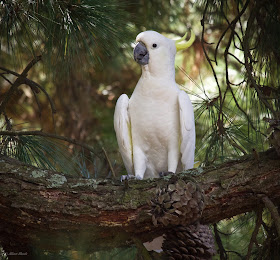Threading a trail through the treetops, savoring blossom after blossom, a Rainbow Lorikeet weaves a pattern as varied as its own.
Lories and lorikeets share the common classification of parrots and there are more than 350 parrots species. Multi-colored in different sizes and shapes, these social and gregarious birds never fail to gain your attention.
Moving among the trees in noisy and sometimes annoying groups, they feed on blossoms, berries and soft fruits. They can be quite disruptive to your backyard activities when two dozen or more medium sized squawking birds land overhead. Australians typically don't feed backyard birds, as Americans do, for this very reason.
Despite their numbers and noisy nature they can be quite difficult to spot high in Australia's eucalyptus trees.
Their feather-light acrobatics are a constant quest for yet another pollen laden blossom.
Heads up, heads down or sideways, lorikeets hang from the thinnest of branches to reach their prize.
Lorikeets have a brush-like end to their tongue to mop up pollen.
Lorikeets mate for life which is easily more than twenty years. Looking alike, you are never quite sure which bird is which.
As the heat of the day surrounds them, they tend to rest in cool shady spots, affording you a chance to see lorikeets in a quiet, relaxed mode.
The long-evolved lorikeet diet is one of fresh, but low-nutritional blossoms. This is one reason you should NOT provide food for lorikeets.
Crowding at unsanitary feeders can easily transmit diseases between birds, something far less likely in a natural setting.
Multi-colored and highly entertaining, the lorikeet family is large and lovely with shades of a rainbow in every bird.
Allan
(Click any picture to enlarge.)
Credits:
Wikipedia
http://animals.mom.me/life-span-rainbow-lorikeet-9339.html,
http://www.environment.nsw.gov.au/animals/TheDangersOfFeedingLorikeets.htm,
http://birdlife.org.au/bird-profile/little-lorikeet
http://animals.nationalgeographic.com.au/animals/birds/parrot/



























